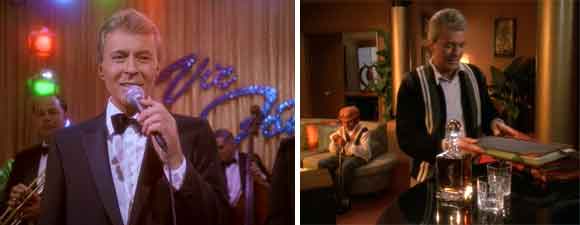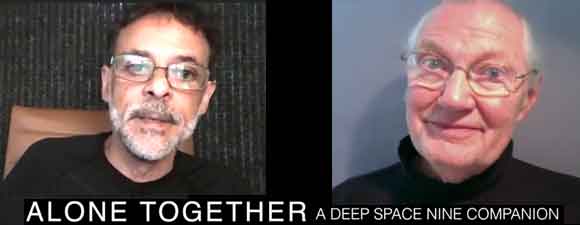Retro Review: The Maquis
8 min readWhen a terrorist group sets out to retake Federation colonies in the Demilitarized Zone from the Cardassians, Sisko must join forces with Gul Dukat to prevent a war.
Plot Summary: After the Cardassian ship Bok’Nor explodes as it leaves Deep Space Nine, Sisko’s old friend Cal Hudson, now a Starfleet attache to Federation colonies in the Demilitarized Zone, arrives to investigate. Privately. he tells Sisko that his presence is a joke, since the Federation has abandoned its colonists when it gave away their territory to the Cardassians. Meanwhile, a Vulcan named Sakonna enters negotiations with Quark to buy weapons. Soon after Hudson departs, Gul Dukat arrives to tell Sisko that he knows why the Bok’Nor was destroyed, and Sisko agrees to accompany him unofficially into the DMZ, where the two find Cardassian ships attacking a Federation freighter which is then defended by a heavily armed Federation merchant ship. Dukat and Sisko interrupt a confrontation between Hudson and Gul Evek over attacks by the Cardassians on Federation colonists, where they all learn that the man who sabotaged the Bok’Nor has confessed and died in Cardassian custody. Hudson tells Sisko that the Cardassians have been shipping weapons to their own colonists and will not stop until the Federation colonies have been destroyed; he believes the Bok’Nor was carrying weapons for that purpose. Dukat swears that this is not true, but once back on DS9 he is kidnapped by some of the Federation colonists. Sisko tracks the abductors’ ship and learns that the renegades who destroyed the Bok’Nor call themselves the Maquis. When he, Kira, and Bashir track the Maquis ship to a planet where they hope to find Dukat, Sisko instead finds Hudson, out of uniform and leading the terrorists.
Sisko insists that his top priority is peace, but Hudson feels that Sisko is siding with the Cardassians and stuns the Starfleet away team in order to escape. Back at DS9, Admiral Nechayev indicates Starfleet’s fear that the Maquis could start a war and Cardassian Legate Parn arrives to accuse Dukat of being personally responsible for arming the Cardassians in the DMZ. Meanwhile, Odo learns of Quark’s weapons sale to Sakonna, who is now attempting to interrogate a contemptuous Dukat. Sisko takes a team to retrieve Dukat and sends a Maquis fighter to tell Hudson that he still believes they can work out their differences peacefully. Irritated that Parn did not rescue him and tried to frame him for the weapons shipments, Dukat agrees to help Sisko stop the weapons smuggling on both sides, helping Sisko to track a Xepolite trader who planned to transfer weapons from the Bok’Nor to Cardassian settlers. Quark suggests that Sakonna do the logical thing and work with Sisko; she then warns Starfleet that the Maquis have plans to blow up a secret Cardassian weapons depot. Sisko visits Hudson to try to talk him out of it, but Hudson disintegrates his Starfleet uniform rather than put it back on. When the Maquis arrive to destroy the Cardassian weapons, Sisko’s crew is waiting. The two groups of ships each disable the other. Sisko has Hudson under a phaser lock but refuses to kill his friend, allowing Hudson to flee into the Badlands while Dukat tries to order Sisko to shoot. Returning to the station, Sisko declines Kira’s congratulations on having prevented a Federation-Cardassian war, believing he has only delayed the inevitable.
Analysis: The two parts of “The Maquis” were pretty good to begin with and they’ve only become more relevant and resonant with time, both in terms of the Star Trek franchise and in terms of similar situations in the contemporary world. The storyline was engineered as a launching point for Voyager, so that the crew would be comprised of Starfleet officers and rebels who would have to work together, but it also provided the moving conclusion to Ensign Ro’s story arc on The Next Generation and created a terrific conflict on Deep Space Nine that would culminate in Sisko’s lover being sent to prison for collaborating with the Maquis. I truly love the concept of a group that shakes Starfleet and the Federation out of a complacent sense of always being in the right and forgetting that not everyone lives in the paradise that Earth has become, as Sisko notes bitterly in a rant to Kira. It’s all very well to believe that in the future, humans will, like Vulcans, put abstract ideals over concrete realities, but it’s simply not plausible to think that everyone – particularly people who haven’t taken an oath to Starfleet – will be willing to sacrifice lives for the greater good. Here’s a group which doesn’t preach that the good of the many outweighs the good of the few, which is willing to start a war if that’s what it takes to get justice for their cause. Their methods may be different from Starfleet’s but their values and initiative are never put down. Given the inconsistent application of the Prime Directive and Starfleet’s wimpiness when it comes to the Cardassians, failing to stick up for the Bajorans during decades of occupation, hastily crafting the treaty in “Journey’s End” and abandoning these settlers, I have a lot of sympathy for the people who built lives on what became the wrong side in the DMZ, refused to move, then refused to be driven out.
Sisko’s internal conflict is portrayed here as a struggle between friendship and loyalty to Starfleet, but as the conflict with the Cardassians deepens, it becomes increasingly obvious that he’s always accepted more shades of gray and always been more willing to challenge Starfleet ideology at the highest levels than Picard was (Kirk, a man of action, was often willing to go against what he saw as a problematic regulation, but he was rarely as introspective as his successors). “The Maquis” is my favorite Sisko episode of the series thus far. I love the glimpses we get into his past, when he was surrounded by a happy family and friends and he sounds like a different person than the one we’ve gotten to know since Jennifer’s death. Hudson’s teasing about being dragged to dress balls and having to deal with Dax now in a woman’s body shows us a side of Sisko that we rarely get to see, particularly as Dax feels more accepted as Jadzia and calls on Sisko’s bond with Curzon less and less. Even as it’s showing up glimpses of a more carefree Sisko from the days before the Borg attack, it’s reminding us that his sense of good and evil has always been complicated by his losses and his sense of personal history. “The Maquis” is in some ways his “Past Prologue”: though he starts out confrontational with Kira, suggesting that he may not want to hear her perspective on the Cardassians, he makes clear in the end that he understands what she’s been fighting for and why she can’t let it go for an abstract like peace. Sisko has to make a similar decision to turn his back on a friend turned terrorist, a friend who speaks of the Cardassians very similarly to the way Sisko’s first officer speaks of them.
Usually in Star Trek as we come to know and understand a civilization, like the Klingons and Romulans, we’re encouraged to understand their different ideologies and to try not to judge them even if they routinely lie about business or treat women like second class citizens. The better we know the Cardassians, however, the less reason we have to trust them. It will take the near-destruction of their civilization for them to become dafanged. Hudson makes a terrific foil for Sisko precisely because the two seem so alike at first in their values and career paths, their relationships with Curzon, their concern for the people who are their responsibility. Is Sisko enough like Hudson that, pushed beyond tolerance, he would burn his uniform and break his oath? He’s bent regulations beyond all recognition, like when he refused to abandon Deep Space Nine as the Bajoran militia arrived to take it, but that’s more akin to Kirk’s warping directives; Kirk always believed that what he was doing was legitimate while wearing the uniform, whether it was taking Spock to Vulcan against orders or killing a native god to free its worshippers. Sisko’s concern for Hudson till the very end appears to be that his friend is throwing away a career, not that he may start an interplanetary war; Sisko makes no more attempt to reason in that way than Kira did with the Bajoran farmer she had to drive off Jerrado to make way for an energy plant. It’s clear that Sisko and Kira both believe in and have lived through the no-win scenario, and heartening to see that, after they finish snapping at each other over Cardassian treachery and Starfleet retaliation, their mutual understanding is greater than ever.
The directing makes good use of the contrasts between the clean, efficient meeting rooms where negotiations are carried out, half-lit rooms where arms are traded, and the dark places where the Maquis do their dirty work – shades of gray in fact as well as in metaphor. If there’s a disappointment in the episode, it’s Dukat, who ends up being nearly irrelevant to the action, a plot device rather than a prime mover. He’s more indignant than irate when he learns that the Cardassians are willing to use him as a scapegoat, and his blustering and threats to destroy any Cardassian who won’t follow his direct order have little heat behind them. Perhaps it’s not fair to judge Dukat from this season by the standards of the compelling madman he will become, but one expects him to be more in the thick of things with Evek, debating philosophy as well as tactics with Sisko, goading Kira just because he can. If he’s going to swear to a lie on the lives of his seven children, there should be greater consequence, even if it’s just Sisko’s anger. He has a lovely moment scoffing at the impotence of the Maquis trying to interrogate him, but even Quark is more interesting, insisting that he only armed the Maquis because Sakonna charmed him with her feminine wiles, then persuading Sakonna that it makes good business sense and is therefore more logical to give up the Maquis plans before war breaks out. Yet the raw, blunt madness of Dukat in later seasons, when he finally admits that he really wanted to do what he only jokes about in “The Maquis” – to exterminate the Bajorans who would not bow to him – still holds traces of this rational, frustrated military leader trying to twist the situation in the DMZ for gain.







Man, Quark was pretty smooth with Sakonna. He kinda went from joke-smooth to actually smooth.
In retrospect, this two-parter is the point for me that DS9 really distinguished itself from Next Gen in storytelling and tone, not just setting. Not all, but a lot of the previous episodes could have been told on TNG with just a few alterations. Here, the show’s lead characters criticize the flaws in Starfleet’s system and its privileged leadership’s perception. It’s a bit of honest rebellion against the system which is not prompted by alien influence or mind control. And, while a solution to the immediate brush fire is found, the Maquis problem is left unsolved with no real idea as to how it will ultimately end. I think it’s a major turning point not just for the series, but for the franchise as a hole.
“whole.” I can’t believe I did that.
Just as an FYI, “be comprised of” is nonsensical in English. Something can ***composed*** of something, or it can ***comprise*** something, but it can’t ***be comprised*** of something.
Just as “The Best of Both Worlds” was the episode that set TNG apart from its predecessor, “The Maquis” gave was what gave DS9 its own identity. Here, we started to see a far less black-and-white universe. The notion of the simplicity of being a “saint in paradise” was the basis for Section 31. And Sisko’s question of whether he just delayed the inevitable to close out the duology was, in retrospect, foreshadowing to the Cardassians allying themselves with the Dominion.
As for Dukat, he seems like a political pragmatist at this stage of the series. Perhaps he saw some value in withdrawing from Bajor, even if he did vehemently oppose it, or to making sure the situation in the DMZ didn’t deteriorate into war. By Season 4, he’s grown increasingly weary in his leaders’ inability to take more decisive action and takes matters more into his own hands.
The Cardassians should have never been created. They were never that interesting.